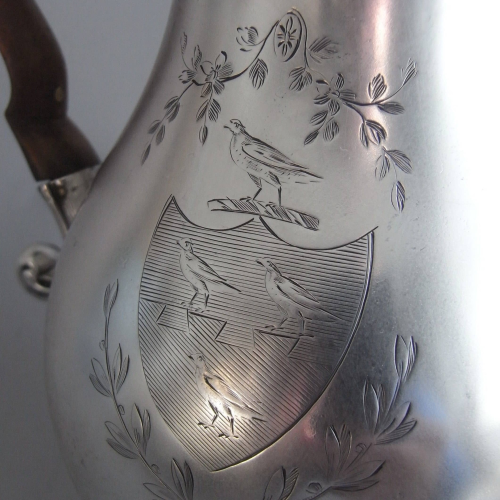

Despite her humble origins, Hester Bateman is widely revered as one of England’s finest silversmiths and the founder of a dynasty that lasted for nearly a century. Her exceptional flatware and ornamental silver remain much in demand today.
She was born Hester Nedem (or Needham) and was baptised in London on October 7, 1708. Little is known about her formative years, other than her parents Elizabeth and John Needham were poor and that consequently she received no formal education.
In 1732 she married John Bateman a metalworker and maker of watch chains who worked predominantly in gold and silver. The pair raised six children until John’s death from Tuberculosis in 1760. Although she worked alongside her husband, we know little of Hester’s early work as it would have been stamped with her husband’s mark.
In his will John left Hester his tools and the workshop at 107 Bunhill Row, Islington where she continued the family business. She was ably assisted by sons John and Peter, together with John Linney, who had served as their father’s apprentice.
Hester registered her first mark with Goldsmith’s Hall in 1761. At the time women were not allowed to use their initials alone as a maker’s mark but exceptions were made in the case of widowed craftswomen.
In those days it was common for workshops to subcontract their work and it is thought that much of Hester’s work at this time was commissioned by fellow silversmiths, who subsequently over stamped the Bateman’s marks.
However, by the mid-1770s the Bateman family had become very successful with Hester employing the latest technology to improve production, reduce costs and compete with their peers. Unlike many companies who specialised in one field of production, the Bateman’s offered a fine and versatile range of goods including tea caddies, wine labels, flatware, dinner plates, coffee pots and even trophies.
What set the Bateman’s work apart from many of their contemporaries was Hester’s attention to detail and the quality of her designs. Her style favoured the neo-classical which was the popular style of the late 18th century, borrowing Greek and Roman motifs, accented by her signature line-beaded edging. To this day a good collector can identify a Bateman piece without even examining the hallmarks.
During Hester’s lifetime the workshop produced thousands of items of fine quality silverware which proved tremendously popular with the emerging middle classes. Her patrons also included many of the City of London Guilds, the Church and wealthy private houses.
Hester finally retired in 1790 at the age of 81, passing away four years later in 1794, but her legacy continued with sons Jonathan and Peter running the workshop. After Jonathan’s passing the following year, his widow Ann joined Peter in the family business and two further generations would keep the workshop running until its eventual closure in 1843.
A remarkable businesswoman, Hester Bateman transformed a small workshop into one of the most successful silversmiths of the Georgian era. Her exceptional work can be seen in many important public and private collections and remains hugely popular with collectors throughout the world.
Image from the stock of Mary Cooke Antiques.
See all available stock by Hester and the Bateman family here.

